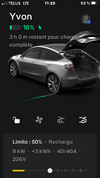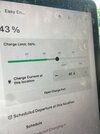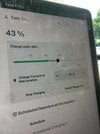Before I insert the handle, the Y shows 48 amps as the charge rate.
As soon as the HPWC's handle is inserted, it shows 40/40 as if the HPWC can't output more.
I do not understand why that is : can someone enlighten me as to a possible fix?
Thanks in advance
Cheers
edited to give more details as to the sequence of events
As soon as the HPWC's handle is inserted, it shows 40/40 as if the HPWC can't output more.
I do not understand why that is : can someone enlighten me as to a possible fix?
Thanks in advance
Cheers
edited to give more details as to the sequence of events
Attachments
Last edited:





